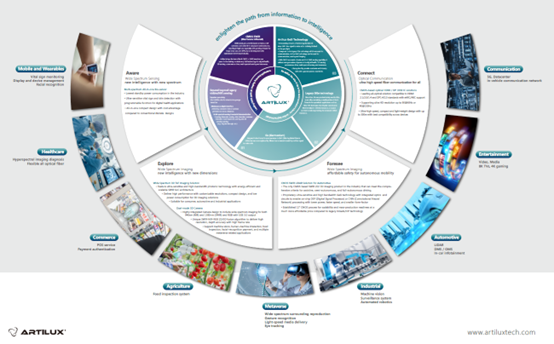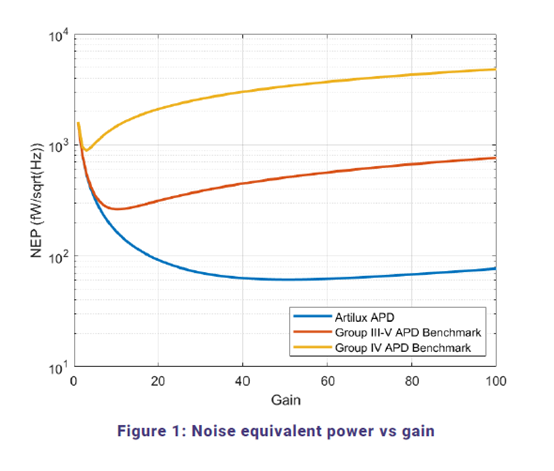Well-known for the world leading GeSi (germanium silicon) photonic technology innovation, Artilux is a provider of SWIR spectrum sensing fundamental semiconductor optical technology platform and solution. Based on this key technology, Artilux takes the crossover challenge of developing integrated optics, system architecture and algorithm, bringing innovation to emerging industries such as consumer electronics, augmented reality, autonomous driving, industrial LiDAR. Recently, TrendForce was honored to invite Erik Chen, CEO of Artilux, to share his prospective on the market trend of SWIR industry and the company’s progress and strategy in this field.
Erik explained that Artilux has been committed to the research and development of GeSi technology in fundamental physics and material science fields for many years. It has not only addressed the technical bottleneck problems remaining in semiconductor industry for decades, but also created an optimal technology platform with high sensitivity, high bandwidth, high integration and cost-effective performance. As LiDAR, Metaverse, under-display sensing and digital health industries enjoyed exponential growth, Artilux has launched a complete GeSi optical sensing technology platform and product lines to meet such industry needs. Technology platform includes GeSi Photodiode, GeSi avalanche photodiode (APD) that have hit the market and GeSi Single-Photon Avalanche Photodiode (SPAD) to be officially released. Its product line covers short sensing range (Digital Health), medium sensing range (Metaverse, Under Display Sensing) and hundreds of meters (LiDAR) applications as a response to meet the diversified demands of SWIR sensing market.

According to TrendForce’s investigation, NIR light source has been used for under display sensing for years, but the panel will absorb NIR light and convert it into leakage current, which results in pixel malfunction and then leads to white spot or screen burn-in phenomenon. However, facing the future under display 3D sensing market with great potential, IR emitter and photodetector manufacturer are proactively developing SWIR and manage to eliminate white spot phenomenon so as to increase the screen-to-body ratio. Erik said on the strength of GeSi’s unique high integration property, cost-effectiveness and the physical properties needed by detecting SWIR waveband, Artilux has cooperated with many large-sized semiconductor laser manufacturers worldwide on various application fields, fully developing sensing, imaging and 3D TOF (iTOF/dTOF) technologies. Meanwhile, Artilux continuously improves and refines relevant intellectual operation and algorithm on the basis of customer feedback and an enormous amount of testing material analysis of SWIR sensing. On the system aspect, the company also joins hands with its partners in the ecosystem to enable the technologies to reach related accuracy required for under display sensing and mobile payment.
As to avalanche photodiode (APD) photodetector, its main signal intensity can be obtained by multiplying quantum efficiency and gain. Currently, mass-produced GeSi technology platform already realizes quantum efficiency of reaching 60%-70%, which is likely to further improve with the progress of semiconductor integrated optical technology under development. Also noticeably, the gain of Artilux’s APD boasts better performance compared to the same product industry wide. Together with Artilux’s ultra-low dark current characteristics, its GeSi APD has made revolutionized progresses on performance, system integration and cost.
Erik also mentioned that Artilux has kicked off the development of automotive LiDAR sensing IC market. According to TrendForce’s survey, Artilux has successfully collaborated with Europe-based and US-based LiDAR manufacturers, providing them with GeSi APD for MEMS LiDAR application. Characterized by compact size, high sensitivity, quick response and no need for high-voltage power supply, this product is applicable to the detection and reception of weak optical signal. System manufacturers’ feedback shows that GeSi APD’s detection performance improves remarkably as system bandwidth and sensitivity synchronously increase. Given the product efficiency and price, GeSi product is believed to live up to customer’s and market expectation.

As e-commerce industry gathers steam, consumer demand for fast and convenient delivery services climbs up, which has become the key to success in logistics e-commerce domain, making the last-mile delivery more challengeable. In an effort to reduce the last-mile delivery cost and improve delivery efficiency, e-commerce and express companies incrementally adopt unmanned delivery robot and autonomous truck, pushing up the demand for delivery robots with self-navigation and smart sensing functions. In face of such a business opportunity, particularly in how to achieve precise sensing under sunlight, Artilux is actively co-developing corresponding solutions with its customers and will soon share the actual development result.
Finally, Erik added that Artilux’s SWIR-based Bio-sensing integrated solution has made great headway. It’s believed that this industry first sensor combing in-ear, skin and biometric recognition can set new technology milestones for new applications related to digital health in consumer electronics market.
Article written by Joanne / TrendForce













